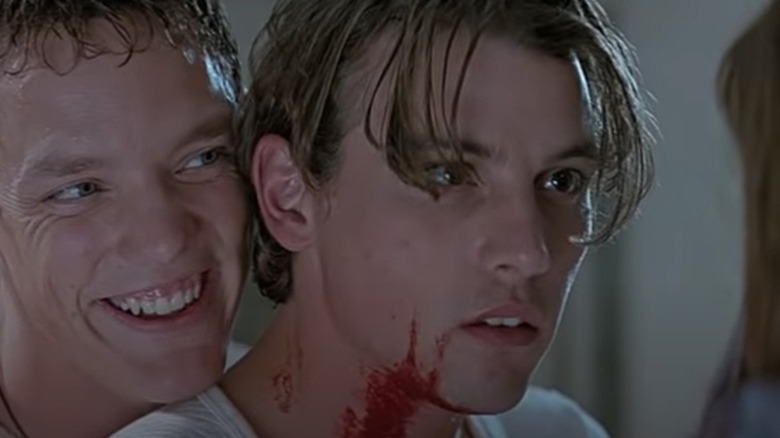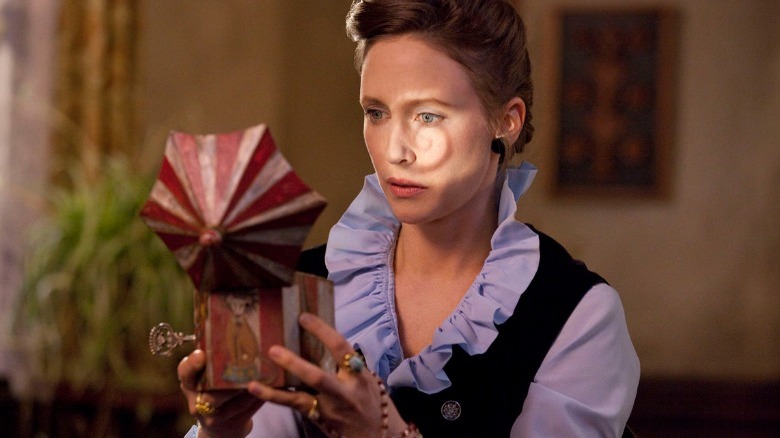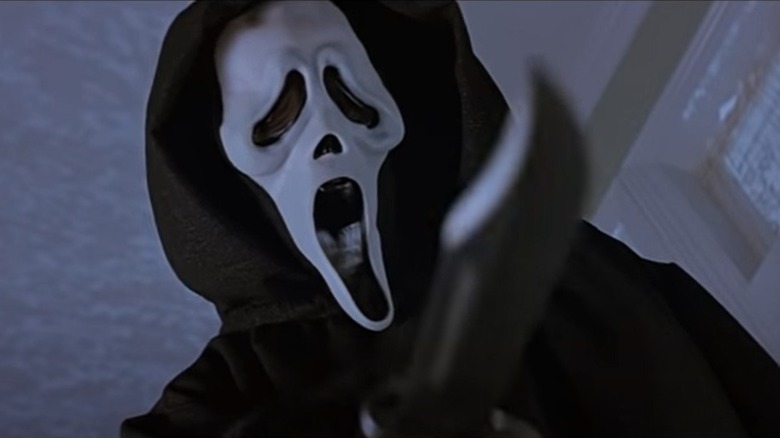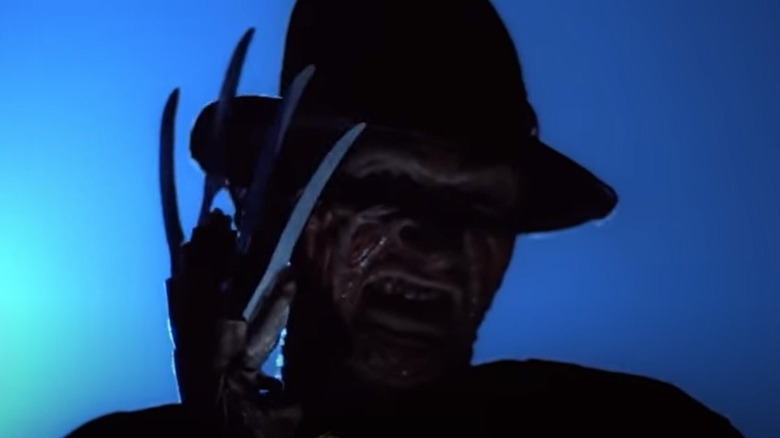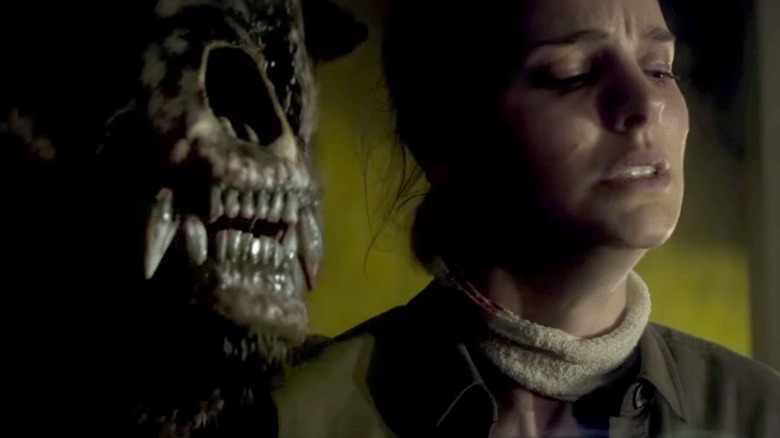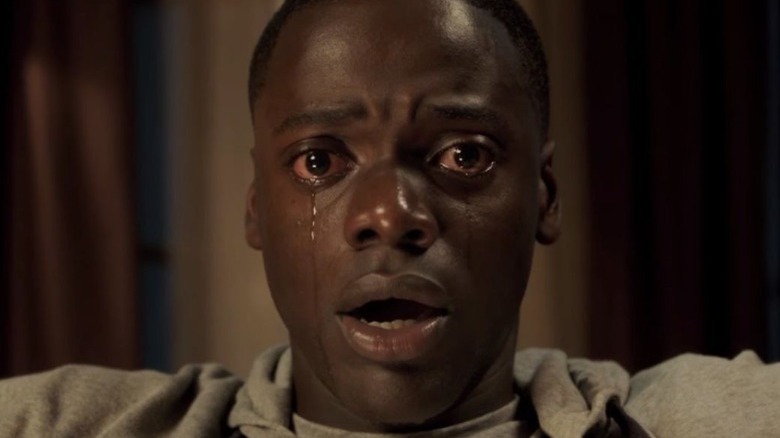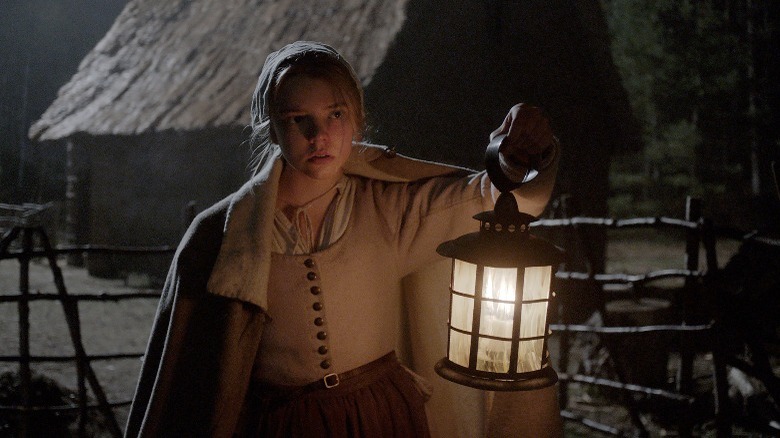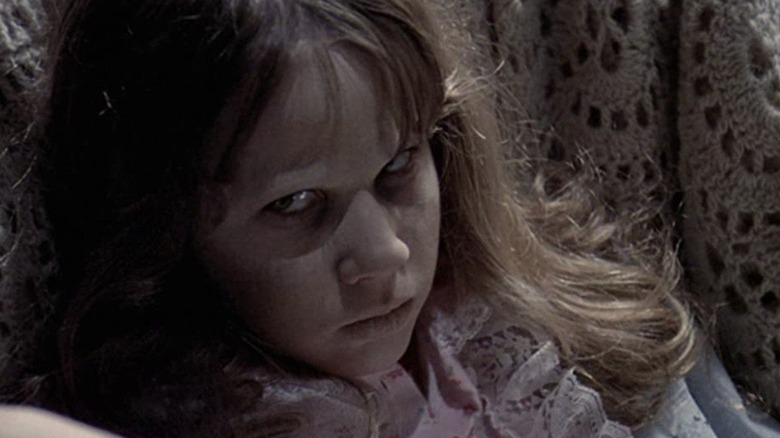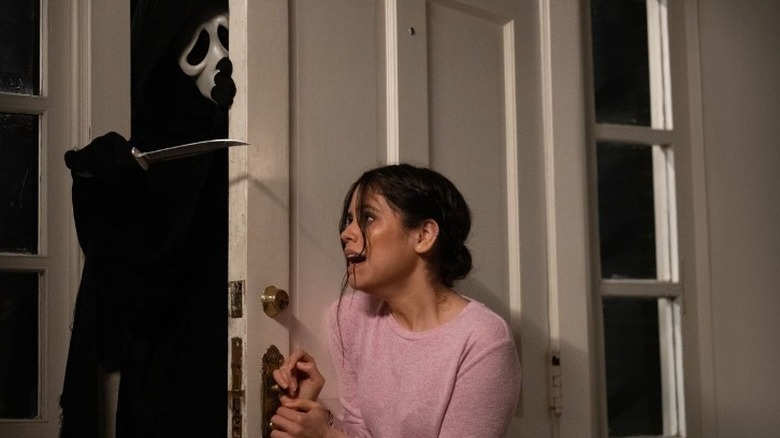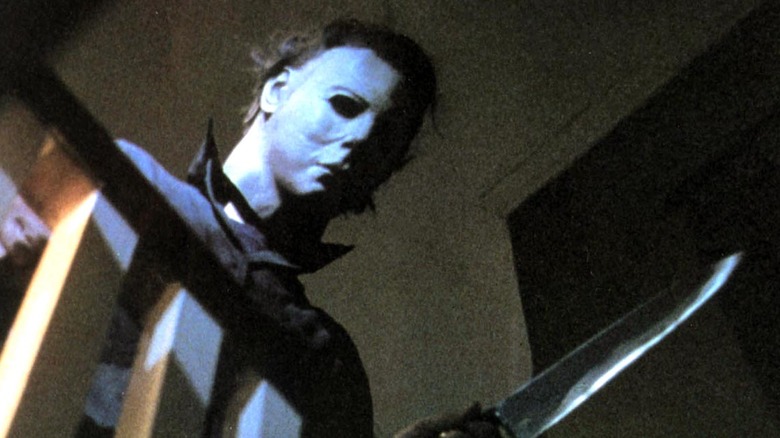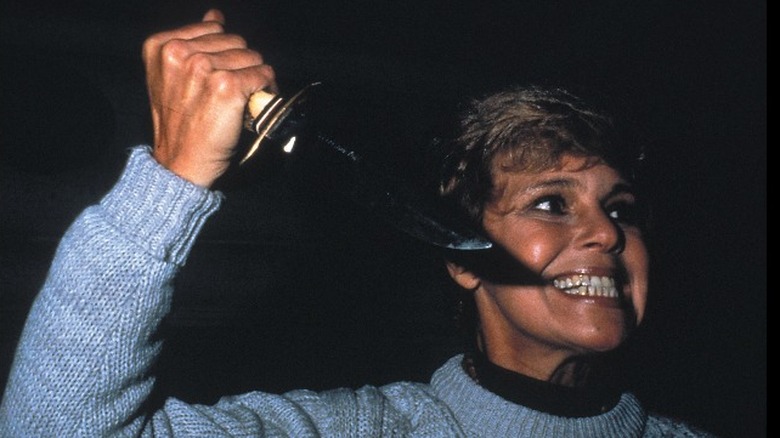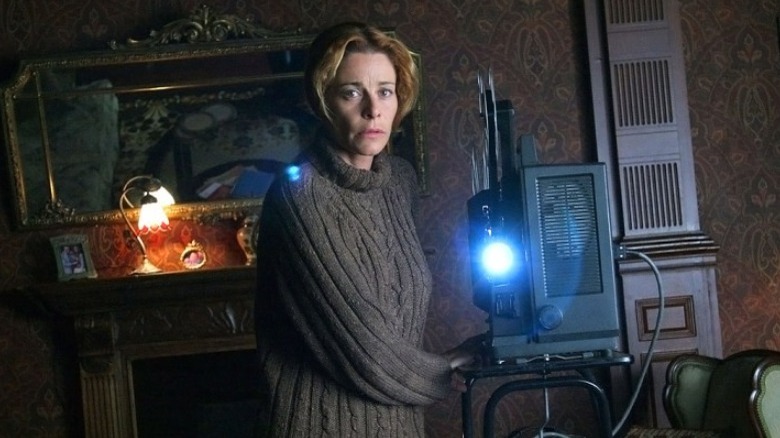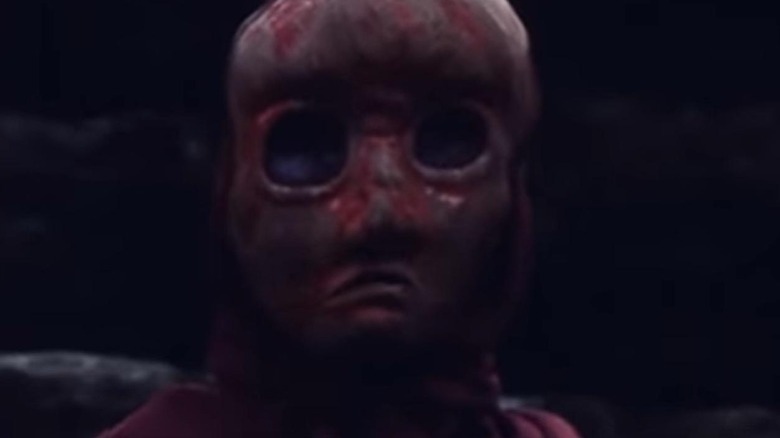12 Theories That Up The Fear Factor Of These Horror Films
What makes the horror genre so sensational is that there's something for everyone. There are killer clowns, ghostly children, haunted houses, and elevated subversive treats. Better yet, even within the same movie, audiences are liable to walk away with a favorite scare of their own. Ask fans of "The Conjuring" which scene rattled them most and you'll get a dozen different answers. Horror films pull from literature, video games, and true stories to generate enduring scares, but sometimes, the audience adds scares of their own.
Just like devotees of the dense lore of fantasy and mythology, horror fans are eager to develop theories of their own. They dissect endings, interpret clues, and speculate about what all the on-screen scares mean. Often, those theories have the unique capacity to render their source material scarier than it originally was. We're examining 12 horror movie theories that seriously amp up the scare factor. Some of these are fan-generated, while others spawn from seriously frightening behind-the-scenes anecdotes. You've been warned.
The Conjuring
A horror movie based on a true story that haunted its real cast? That's scary stuff.
"The Conjuring" is one of this century's scariest haunted house movies. Director James Wan didn't just reinvent the haunted house, he burned it down and erected a terrifying new property all his own. The first (and best) in the series tells the simple story of the Perron family and their haunted Rhode Island farmhouse. Constrained by limited resources, they're forced to endure the hauntings until famed paranormal investigators Ed and Lorraine Warren (Patrick Wilson and Vera Farmiga) arrive to put an end to it.
Even scarier than what's on-screen are the stories the cast told during production. According to E!, star Vera Farmiga, saw claw marks on her computer screen while filming, later saying, "After we got back from North Carolina, where we filmed, the same claw marks appeared on my thigh." Shanley Caswell, who plays Andrea Perron, remarked, "Every time I woke up, I just felt like I was being watched."
Whether those stories are true or not, they add a terrifying new layer to the enduring supernatural scares of "The Conjuring."
Scream
Horror films have been known to adapt real-life occurrences for their fictional scares. However, even those that don't seem to be rooted in anything true have their share of disturbing real-world inspirations. Such is the case with Wes Craven and scribe Kevin Williamson's groundbreaking meta-horror exercise "Scream." Their 1996 slasher radically reinvented the horror genre, immediately cementing the film's classic status as a self-aware though no less terrifying dissection of what the horror genre is and could be.
Even scarier, though, is how the idea originally manifested with writer Kevin Williamson. According to CNN, Williamson first developed the idea after he and a friend saw a news report on the Gainesville Ripper, a serial killer who murdered eight people in 1990, five of whom were students at the University of Florida. Williamson remarks, "I was getting so spooked. I was being scared out of my mind."
While the fictional Ghostface killer and the Gainesville Ripper have little in common, it's difficult to overlook how both had their respective communities holding their collective breath. Truth is often more frightening than fiction.
A Nightmare on Elm Street
Because of Samuel Bayer's 2010 remake of "A Nightmare on Elm Street," fans should be forgiven for forgetting that, in the original movie, Freddy Krueger isn't a child molester. Instead, in Wes Craven's groundbreaking 1984 masterpiece, Krueger is simply said to be a child murderer. The more sordid and terrifying elements of Krueger's backstory were removed from the script on account of a real series of child abuse cases in and around California at the time.
Although it is never explicitly acknowledged, the roots are there. In the film, the full extent of Krueger's crimes is never known, though it is clear from both his dreamscape killing spree and a gaggle of reticent parents that he's more monstrous than anyone is willing to let on. With a series of original victims who were all young children, it's hard not to presume Krueger did much worse. Although it was a wise omission that prevented "A Nightmare on Elm Street" from being darker than it likely needed to be, the Springwood Slasher's origins still cast an ominous, terrifying aura over a horror icon later reduced to a walking, nocturnal joke book.
Annihilation
Distribution issues aside, "Annihilation" was one of 2018's best horror movies. Director Alex Garland of "Ex-Machina" fame crafted a sci-fi horror hybrid abounding with cerebral scares and a smattering of full-bore body horror. It has its roots in the early works of David Cronenberg, but it still seems altogether unique, a singular vision from a singular creator. Diverging from Jeff VanderMeer's source material, the ending of Garland's "Annihilation" left the internet abuzz with dozens of theories about what it all might mean.
One of the best — and scariest — interpretations is that "Annihilation" is about cancer. In the film, it's made clear that the Shimmer, an unusual expedition zone full of odd phenomena, can refract and mutate cells, destroying a person from the inside out. Current and former cancer patients, including Mike X. Nichols of Film School Rejects, have remarked just how much "Annihilation" gets right about the human body's innately self-destructive tendencies. Yes, mutated bears and alligators are scary, but our own body's desire to destroy itself is even scarier.
Us and Get Out
Director Jordan Peele has quickly become a horror icon. With two films under his belt and a third on the way, fans can't help but speculate whether his films are connected in any meaningful ways. Though nothing concrete has emerged, and that might change this summer with the release of "Nope," there are many fan theories that draw some interesting connections, most notably between the antagonistic Armitage family of "Get Out" and the tethered, the underground doppelgängers who break free to terrorize their doubles in "Us."
According to IGN, Peele explains in a "Get Out" behind-the-scenes commentary that the film is about the Holy Grail. He says of the Armitage family, "They believe they are destined for immortality and deity status, and over hundreds of years, they have worked to figure out through science a way to achieve the power of the Holy Grail."
Though not directly linked, it's not unreasonable to consider how the tethered from "Us" are direct descendants of the Armitages' interest in achieving immortality. After all, a double of oneself is a reasonable start. Moreover, "Us" makes it clear that the tethered, with roots stretching back as far as time, have been all but abandoned. That tracks with the Armitages' centuries-long interest in artifacts. It's scary to think that before "Get Out," this family created doubles, and realizing they wouldn't work, consigned them to a life of misery deep underground.
The Witch
In an interview with The Verge, "The Witch" director Robert Eggers said he hoped to bring "Puritan fears to a modern world." Given "The Witch's" legacy and enduring appeal, it's clear he was successful. Much like other films in A24's unique oeuvre of horror, "The Witch" is open to considerable interpretation. Was the titular witch real at all? Was there anything supernatural occurring? Did Puritan fear manifest in the worst possible way? All or none of those may be true, but given Eggers' remarks and a curious early prayer from Thomasin (Anya Taylor-Joy), it's possible that Satan was not only there, but he was directly summoned by Thomasin.
Early in "The Witch," Thomasin prays, saying, "I here confess I've lived in sin. I've been idle of my work, disobedient of my parents, neglectful of my prayer. I have, in secret, played upon thy Sabbath, and broken every one of Thy commandments in thoughts." She later says she deserves shame and misery and begs for mercy. It's likely, then, that Thomasin's prayer was answered, just not by whom she intended.
Eggars remarks, "It's a tragedy to read about a young girl upsetting someone, and since she didn't think she could have the kind of power to create that reaction, it has to be the devil." Feminist underpinnings ground the idea that Thomasin, feeling distinctly feminine guilt, freed herself from shame with a dollop of devilish assistance.
The Exorcist
This theory is considerably more nuanced than the others listed here. Though for those inclined to believe it, it adds a terrifying new wrinkle to one of the scariest movies ever made. According to English scholar Tom Graham, Regan (Linda Blair) isn't simply possessed by Pazuzu, the central demon wreaking havoc in "The Exorcist." According to Graham, Regan is Pazuzu.
Graham notes, "In keeping with Pazuzu's Sumerian origins, then, we can consider Regan's symptoms as the physical manifestations of as aspects of the demon." That is to say, Regan is capable of miraculous physical feats, including levitation, abnormal strength, and even the ability to twist her head a full 360 degrees. "After all," Graham says, "the demon does not cause the symptoms of possession, the demon is the symptoms of possession." As scary as a possessed child is — and given "The Exorcist's" enduring appeal, it's a pretty scary concept — it's considerably more frightening to consider the complete physical takeover of Regan by Pazuzu. Her body is his and that's a terrifying thought.
Scream (2022)
Horror fans, especially "Scream" fans, love unconfirmed deaths. Radio Silence, the directing duo behind the gloriously profitable 2022 "Scream" reboot, played into these theories, including an Easter egg confirming that Kirby Reed (Hayden Panettiere) of "Scream 4" survived her attack. Though likely a bit of fan service with no narrative grounding, "Scream" fans are fervent speculators, a tendency best conceptualized with original killer Stu Macher.
As early as 2010, fans speculated that Matthew Lillards' Stu Macher might return to the series, pointing to the lack of on-screen evidence he's truly dead. According to IGN, "The Matthew Lillard character was pretty beaten up by the end of the 1996 original and presumed dead, but we never see any kind of concrete proof that he didn't make it out of that kitchen." The theory is that Stu has been biding his time, plotting his revenge against Sidney Prescott (Neve Campbell) and company. While it's unlikely, it would add a scary new angle to the enduring nature of violence and revenge in a series abounding with rich themes.
Halloween
Michael Myers is the Antichrist. Compared to some other theories mentioned here, this one likely has the most grounding in text. Writer Daniel Farrands of "Halloween 6: The Curse of Michael Myers" was the first scribe to introduce Michael Myers' supernatural origins. In an interview with Rue Morgue, Farrands recounts his role in the notoriously difficult production. It was that film that introduced the Cult of Thorn, a Samhain cult that imbues a baby Myers with supernatural abilities. Though alluded to in past entries (Michael has always been somewhat invincible and possessed superhuman strength), "The Curse of Michael Myers" made his supernatural origins explicit.
It's also a thread that has manifested in David Gordon Green's rebooted trilogy, so it shows no signs of slowing down soon. Yet, it's reasonable to take it one step further. Michael Myers is the Antichrist. With conceptive roots parallel with those of Damien from "The Omen," Myers was marked from birth to murder and wreak havoc. The power he possesses is likely the power of the devil himself, granted by an ancient cult.
Friday the 13th
Matt Slovick of The Washington Post was kind enough to delineate the history of the "Friday the 13th" franchise. In his 1996 article, Slovick outlines the plot of "Jason Goes to Hell: The Final Friday" in which killer Jason Voorhees is killed. Jason's spirit and heart to survive, and he's capable of possessing other bodies around Camp Crystal Lake to prolong his murder spree. Yet, given his new late-game mythos, it's fun to look back to the first entry in which Jason's mother, Pamela, is the killer.
Given Jason's capacity to possess others and his appearance at the end of the first film, it could be argued that Pamela Voorhees was only compelled to return to Crystal Lake and slaughter counselors because she was possessed by Jason. Better still, he returns in earnest for "Friday the 13th Part 2," and per the "Jason Goes to Hell" mythos, Jason requires a family member to be reborn. Applying the rules of "Jason Goes to Hell" to the first film, it seems that Jason may have possessed his mother and then used her body to return to his own. This theory adds a compelling supernatural angle to his rampage and better grounds his unmitigated rage.
The Orphanage
"The Orphanage" is arguably this century's best ghost story. Director J.A. Bayona and producer Guillermo del Toro crafted a tender, gothic, and thoroughly terrifying ghost story to match the classics of the subgenre. As in Shirley Jackson's "The Haunting of Hill House," it could be argued that the spirits exist only in the mind of the protagonist, namely Belén Rueda's Laura.
In an interview with Filmmaker Magazine, Bayona recounts drawing inspiration from Henry James' ambiguous ghost story "The Turn of the Screw," noting he intended to "let the audience interpret the story at the end." That being said, it could be argued that there are no ghosts at all. The first appearance of a child named Tomás could reasonably be interpreted to be Laura's son, Simón, right before his disappearance. After he's gone, it could likely be Laura's mind, not reality, leading her to believe the ghosts are real. It should be noted that the first tangible appearance of the ghosts only occurs after Laura overdoses on sleeping pills to bring herself closer to death. Being driven to see what isn't there because of grief and loss is scarier than any haunted house.
Noroi: The Curse
Found footage films relish their verisimilitude. In 1999, "The Blair Witch Project" purported to be genuine footage, leading unsuspecting audiences to believe that what they were seeing was real. Of course, it isn't real, and it's been more difficult to fool viewers in the digital age in which nothing stays secret for long. However, some movies have proven themselves to be successful in attaining a similar urban legend status.
Such was the case with Kōji Shiraishi's "Noroi: The Curse," a 2005 Japanese found footage horror film that remained unavailable (legally) in the United States until 2020. According to GQ, stories about the movie spread like wildfire on internet forums and horror blogs, with viewers desperate to get their hands on what was said to be one of the scariest and most disturbing found footage movies ever made. Scarier still was the idea that the movie was deliberately made to be unavailable because of its disturbing content and its roots in reality. Was the curse real? Who is to say? But found footage that generates this much interest always begs those kinds of questions, and that renders "Noroi: The Curse" scarier than it already is.
